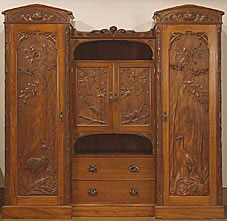Came about after the industrial revolution, as a form of rebellion against overproduction, and over working labourers. It focused greatly on the creation and detail of a product, and the movement was a reaction against the poor aesthetic qualities of products manufactured during the industrial revolution. It could be considered a socialist reform which started in Great Britain, and embraced al types of artists in the production process. Artists care about the way things look, as opposed to the monetary benefits of production.
The Arts and Crafts movement acted as a bridge between traditional Victorian values, and the modernist movement. It was a case of complicating objects opposed to simplifying objects. It represented a balance of harmony with complexity within pieces of work.
An important figure, and seen as the founder of Arts and Crafts, was William Morris. He dedicated his life to re-establishing the values which were once in place before the industrial revolution. He was all about making things "less ugly", through the use of organic shapes and natural materials within the deigns. In an essence it was about establishing the unity of the pieces of art as a whole. Morris emphasised craftsmanship, and the truth to materials to ensure the most aesthetically pleasing outputs of work were created.
In summary, the Arts and Crafts movement involved returning to the creation of work which was pleasing to look at, and rebelling against the mass production of the industrial revolution. Craftsmanship was an important concept, which was an essential part of this movement as a whole.
Here is an example of work from the Arts and Crafts period:

Notice the intricate carving on this piece of work, great attention has been paid to detail, and craftsmanship. The organic shapes carved, are typical of the Arts and Crafts era.
ART NOUVEAU
Literally meaning "New Art" in French, this movement was a direct descendant from the arts and crafts period, and was the first style that spread internationally. This style was used commercially to enhance the beauty of industrial products. Sinuous organic curves were used in the works, which were more free in comparison to those used in the arts and crafts movement. Many of the lines used were plant-like and energetic. It was also essential to ensure that form and function were working together. This movement was also, similar to Arts and Crafts, honest to the materials that were used. Aiming to enhance the function of the materials.
This movement drew heavily on inspiration from Asia, due to increased trade. A large influence from Asia, was woodblock printing from Japan. This had a large impact on posters created at the time, as the shapes used were highly abstracted, and usually had black outlines around objects on the poster. The posters of this era, also usually contained cut-off people in the foreground, bright lights, and often a focus on a subject in the distance. The type had highly organic shapes, only some graduated colour, and little modelling was used. Many of the posters were life-sized, and this could be seen as the beginning of the billboard.
Many of the designers at this time used idealised beauty in their works, depicting women with a "perfect" and elegant shape. Many of the women painted looked self-assured, and quite beautiful.
In terms of composition, there were dynamic spacial relationships, which gave the picture energy, and often destabilised things. The works of this time, were often asymmetrical, where colour created unity and guidance within the images. An example of a designer who summed up all elements of this design movement, was Toulouse Lautrec.
Lautrec used very simplistic shapes, inspired by Japanese printing, also he repeated these shapes and included organic curves. He often abstracted these shapes, simplifying them further. Here is an example of his work:
Look at the simply shaped blocks of solid colour, and organic curves of the feminine body. The style is simple, yet sophisticated, summing up this whole era of design.
The Art Nouveau style made a resurgence in the 60's, where it re-emerged through some of the psychedelic works.

No comments:
Post a Comment